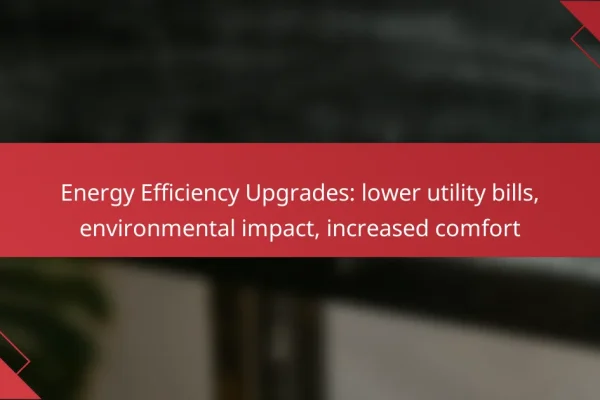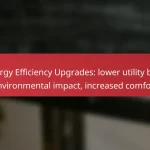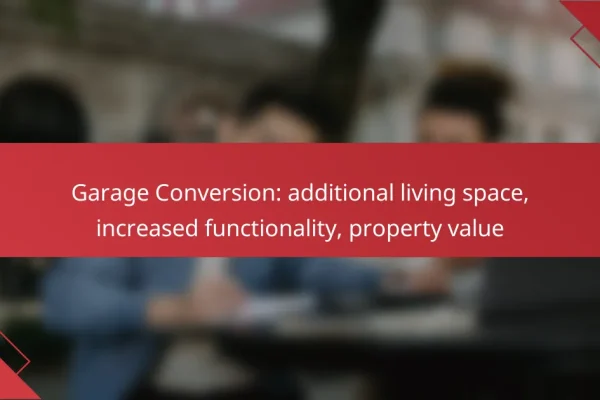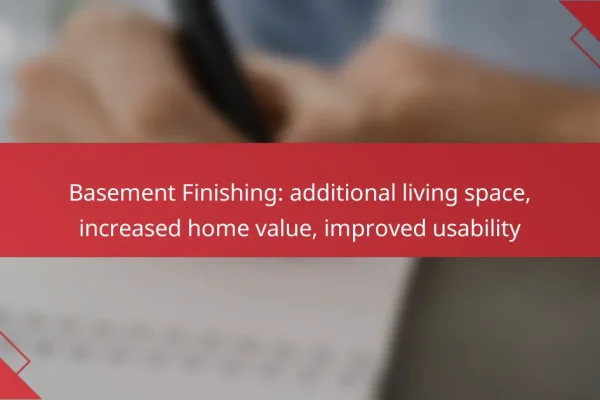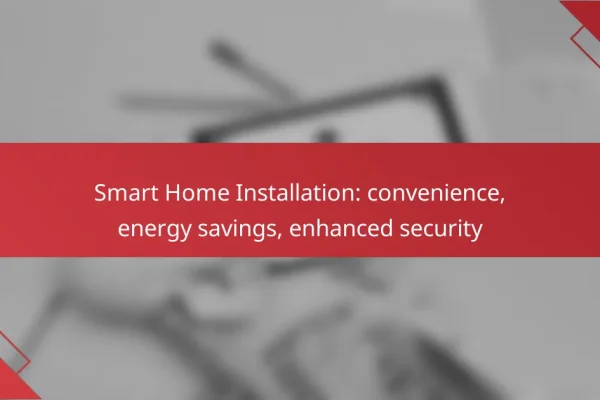Why should homeowners consider improvements in the UK?
Homeowners in the UK should consider improvements to enhance their property’s value, comfort, and efficiency. These upgrades can lead to significant long-term benefits, including increased market appeal and reduced energy costs.
Increased property value
Home improvements can significantly boost your property’s market value. Renovations like kitchen upgrades, bathroom remodels, and adding extra living space often yield high returns on investment, sometimes exceeding 70% of the costs when selling.
Consider focusing on areas that buyers prioritize, such as modern kitchens or energy-efficient features. Research local market trends to determine which improvements are most sought after in your area.
Enhanced energy efficiency
Improving energy efficiency is a key reason for home upgrades. Installing double-glazed windows, better insulation, or energy-efficient appliances can reduce energy bills by a notable percentage.
In the UK, homeowners can benefit from government schemes and incentives aimed at improving energy efficiency, such as grants for insulation or renewable energy installations. These upgrades not only save money but also contribute to environmental sustainability.
Improved living comfort
Home improvements can greatly enhance your living comfort. Upgrading heating systems, improving ventilation, or adding air conditioning can create a more pleasant indoor environment year-round.
Consider your lifestyle needs when planning improvements. For instance, if you work from home, creating a dedicated office space can enhance productivity and comfort.
Personalized aesthetics
Home improvements allow homeowners to tailor their living spaces to their personal tastes. Whether it’s a fresh coat of paint, new flooring, or custom cabinetry, these changes can reflect your style and preferences.
When planning aesthetic upgrades, consider timeless designs that appeal to a broad audience if you plan to sell in the future. This balance can help maintain property value while expressing individuality.
Better functionality
Enhancing functionality is a practical reason for home improvements. Modifying layouts, adding storage solutions, or upgrading fixtures can make daily living more efficient and enjoyable.
Evaluate your current space and identify areas that could be more user-friendly. Simple changes, like adding shelving or reconfiguring a room, can significantly improve how you use your home.
What are the most popular home improvement projects?
Popular home improvement projects typically include kitchen renovations, bathroom upgrades, garden landscaping, and installing energy-efficient windows. These projects not only enhance the aesthetic appeal of a home but can also increase its market value and improve energy efficiency.
Kitchen renovations
Kitchen renovations often involve updating appliances, cabinetry, countertops, and flooring. Homeowners should consider their cooking habits and the overall layout to create a functional space. Budgeting for a kitchen remodel can range from a few thousand to tens of thousands of dollars, depending on the extent of the changes.
When planning a kitchen renovation, prioritize energy-efficient appliances and durable materials. Avoid common pitfalls like over-customization, which can limit the appeal to future buyers.
Bathroom upgrades
Bathroom upgrades can significantly improve comfort and functionality. Key areas to focus on include fixtures, tiles, and storage solutions. A typical bathroom remodel can cost anywhere from several thousand to over twenty thousand dollars, depending on the scope of work.
Consider incorporating modern features such as water-saving toilets and heated floors. Always ensure that plumbing and electrical work complies with local building codes to avoid costly issues later.
Garden landscaping
Garden landscaping enhances outdoor spaces and can increase curb appeal. Popular options include planting trees, shrubs, and flowers, as well as adding pathways and patios. Costs can vary widely based on the size of the area and the complexity of the design.
When landscaping, choose native plants that require less maintenance and water. Avoid overcrowding plants, which can lead to competition for resources and unhealthy growth.
Energy-efficient windows
Installing energy-efficient windows can reduce heating and cooling costs while improving comfort. Look for windows with high energy ratings, which indicate better insulation and reduced energy loss. The investment typically ranges from a few hundred to several thousand dollars per window, depending on the type and installation complexity.
Ensure that the windows meet local energy efficiency standards. Consider hiring a professional for installation to guarantee proper sealing and insulation, maximizing the benefits of your investment.
How do home improvements affect energy bills?
Home improvements can significantly lower energy bills by enhancing a property’s efficiency. Upgrades such as better insulation, energy-efficient windows, and modern HVAC systems reduce the amount of energy needed for heating and cooling.
Lower heating costs
Improving insulation and sealing air leaks can lead to lower heating costs during colder months. For instance, adding insulation in attics and walls can reduce heat loss by up to 30%, resulting in savings on heating bills that can range from 10% to 20% annually.
Consider upgrading to energy-efficient windows, which can further minimize heat loss. Double or triple-pane windows with low-emissivity (Low-E) coatings can help maintain indoor temperatures, reducing the need for heating systems to work as hard.
Reduced cooling expenses
Home improvements that enhance ventilation and insulation can also lower cooling expenses in warmer months. Installing a programmable thermostat allows homeowners to optimize cooling schedules, potentially saving 10% to 15% on air conditioning costs.
Additionally, shading devices such as awnings or planting trees can block direct sunlight, keeping homes cooler and reducing reliance on air conditioning. These measures can lead to noticeable reductions in monthly cooling bills, especially in regions with hot climates.
What financing options are available for home improvements?
Home improvements can be financed through various options, including home equity loans, personal loans, and government grants. Each option has its own benefits and considerations, making it essential to evaluate which best suits your financial situation and project needs.
Home equity loans
Home equity loans allow homeowners to borrow against the equity they have built up in their property. Typically, these loans offer lower interest rates compared to personal loans since they are secured by the home. Borrowers can usually access a percentage of their home’s value, often up to 80% or 90% of the equity.
When considering a home equity loan, be aware of the closing costs and fees that may apply. It’s also crucial to ensure that your monthly payments remain manageable, as failing to repay could result in losing your home.
Personal loans
Personal loans are unsecured loans that can be used for home improvements without requiring collateral. These loans generally have higher interest rates than home equity loans but can be a good option for those without significant home equity or who prefer not to use their home as collateral.
To qualify for a personal loan, lenders typically assess your credit score and income. It’s advisable to shop around for the best rates and terms, as they can vary significantly between lenders. Keep in mind that repayment terms usually range from three to seven years.
Government grants
Government grants for home improvements are often available to assist low-income homeowners or those making energy-efficient upgrades. These grants do not require repayment, making them an attractive option for eligible individuals.
Eligibility for government grants can vary based on income, location, and the type of improvements being made. It’s beneficial to research local and federal programs, such as the Weatherization Assistance Program or HUD’s Community Development Block Grant program, to find opportunities that may apply to your situation.
What are the best home improvement trends in the UK?
Current home improvement trends in the UK focus on sustainability and technology integration. Homeowners are increasingly opting for eco-friendly materials and smart home devices to enhance comfort and efficiency.
Sustainable materials
Sustainable materials are becoming a priority for many homeowners in the UK. These materials, such as bamboo, reclaimed wood, and recycled metal, reduce environmental impact and can improve the overall aesthetic of a home.
When considering sustainable options, look for certifications like FSC (Forest Stewardship Council) for wood products or Energy Star ratings for appliances. This ensures that your choices contribute positively to the environment while maintaining quality.
Additionally, using local materials can minimize transportation emissions and support the local economy. For example, sourcing stone or brick from nearby quarries can be both eco-friendly and cost-effective.
Smart home technology
Smart home technology is reshaping how homeowners interact with their living spaces in the UK. Devices such as smart thermostats, security systems, and lighting can enhance convenience, security, and energy efficiency.
To get started with smart home technology, consider integrating a central hub that connects various devices, allowing for seamless control via a smartphone or voice commands. Popular options include Amazon Alexa or Google Home.
When selecting smart devices, prioritize those that are compatible with existing systems and offer robust security features. This helps protect your home network from potential vulnerabilities while enjoying the benefits of automation.
